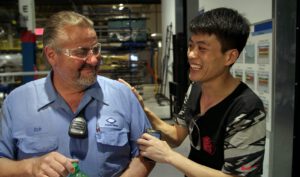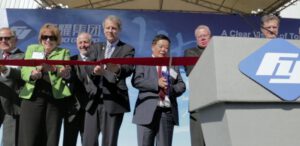Movie Info
Movie Info
- Director
- Steven Bognar and Julia Reichert
- Run Time
- 1 hour and 35 minutes
- Rating
- PG
VP Content Ratings
- Violence
- 0/10
- Language
- 1/10
- Sex & Nudity
- 0/10
- Star Rating
Relevant Quotes
I know that there is nothing better for them than to be happy and enjoy themselves as long as they live; moreover, it is God’s gift that all should eat and drink and take pleasure in all their toil.

In their Oscar-winning documentary directors Steven Bognar and Julia Reichert return to the same Moraine, Ohio plant where they filmed their acclaimed short film The Last Truck: Closing of a GM Plant back in 2008. At the beginning their new one is a more optimistic film—at least the 1000 newly hired workers of the Dayton area are—because Chinese billionaire Cao Dewing, always referred to in the film as “The Chairman,” has struck a deal with the state of Ohio and local authorities to open an auto windshield plant there. The film is a great study in culture clash, capitalistic management, and ultimately, power struggle, as represented in corporate management’s opposition to unions.
At first everyone is aglow with the opening of the Fuyao plant offering work to many who had endured 3 years of unemployment following the departure of General Motors. The Chairman himself comes to the plant and walks the floor to welcome his new workers. There is a core of 200 Japanese workers to train the Americans in both the technical aspects of the manufacturing of auto glass and the ways of the Chinese work ethic. One American worker fondly describes his new friendship with such a coworker, the man often a guest in his home where he learns how to shoot a gun and other aspects of blue-collar recreation.
However, though an American female worker is glad to have a job again, she ruefully points out that at her unionized GM job she had made over $29, she now makes $12 an hour. The film really turns darker when Ohio Senator Sherrod Brown at the festive ribbon cutting ceremony brings up the subject of unionization of the factory, declaring he stands with the workers in their attempt. Several of the Japanese executives are angry at this, wondering how the Senator sneaked that into his remarks. One declares that he will never be allowed to visit the plant again.

The Chairman, we see, is a hands-on man, critical that a smoke alarm spoils the aesthetics of a wall. Demanding that it be moved over to a lower height, the answer of an American that it is required by safety law to be placed at that height is brushed aside. We soon see that safety is the last thing he and his staff care about. Later on, a worker, describing his perfect safety during his long employment at GM, is injured during his first week at the new plant. Another American worker will lament that the company illegally dumps dangerous chemicals into the sewage system.
Both groups of employees bring their prejudices to work, though, as mentioned above, some Americans change their views when they invite the foreigners into their homes. To the Chinese, Americans are lazy because of their refusal to work the 12-hour shifts commonplace in Chinese. When a group of select Americans are selected to go to China for an intense period of training, this Chinese arrogance toward Americans and their refusal to accept impositions is intensified.
The Americans are subjected to daily group line-ups in which factory workers sing company songs and forms of regimentation unheard of in America. Dressed sloppily in leisure clothes when they meet with company officials, the are a stark contrast to the suit and tie Chinese executives. They marvel at tales of Chinese workers who are far from home, work long hours 6 days a week, and because of lack of leisure time, seldom get to return home for visits. At the end of their visit the company holds a festive banquet that features a huge song and dance revue permeated with company propaganda about work and dedication. The latter seems so alien to us that we can imagine how Americans would satirize it were a company attempted such a brain-washing ploy here!
Back in Dayton the drive to unionize creates a cleavage between management and labor, and among the workers themselves, many whom are fearful for their jobs. The Manager had made clear his staunch opposition to a union, saying at one time that he would rather shut down the plant than accept a union. Supervisors keep close tabs on workers advocating unionization, of the latter referring to the pro-union film Norma Rae. When one worker insists on walking through the plant speaking out for the union, security is called, and he is escorted out. A great many workers are fired, so that when the vote is at last held, the union loses overwhelmingly.
Although the very existence of the film shows that Steven Bognar and Julia Reichert are very much for the workers, they are different from Michael Moore in that they provide no narrator commenting on the events. They let each side speak for themselves, which because they spent long hours getting to know their interviewees, they apparently are able to blend into the background as their cameras capture the words of their subjects. There are some surprising moments when we see the Chairman alone on his company jet reflecting about his experiences. The film does not demonize him, or other management officials interviewed. But at times, the Chairman’s words are chilling enough with no need for editorializing on the part of the filmmakers. Especially at the end as he walks through a factory in which robots are replacing workers in fabricating the windshields, he seems very satisfied that in the future he will not have to deal with so many recalcitrant workers. Clearly the technological changes coming to this Chinese-owned and controlled factory do not bode well for American workers—nor for those in China.
This is a fine film revealing culture clash and the inherent difference between management and labor in the running of a company—the former concerned for profits, the latter for job security. From the perspective of power, it is management that is in the superior position when they can fire a pro-union worker without the law or politicians willing to protect the workers. Management’s lack of concern for safety flows from its view that workers are but cogs in a machine, replaceable by more compliant workers and eventually by cogs called robots. This well-crafted film is a valuable social document bound to make viewers think. It deserves its Oscar—and your support. We are again indebted to Netflix for picking it up.
This review will be in the May issue of VP along with a set of questions for reflection and/or discussion. If you have found reviews on this site helpful, please consider purchasing a subscription or individual issue in The Store.
